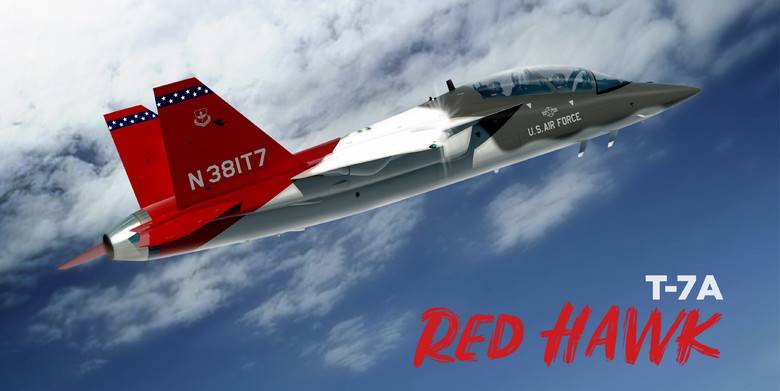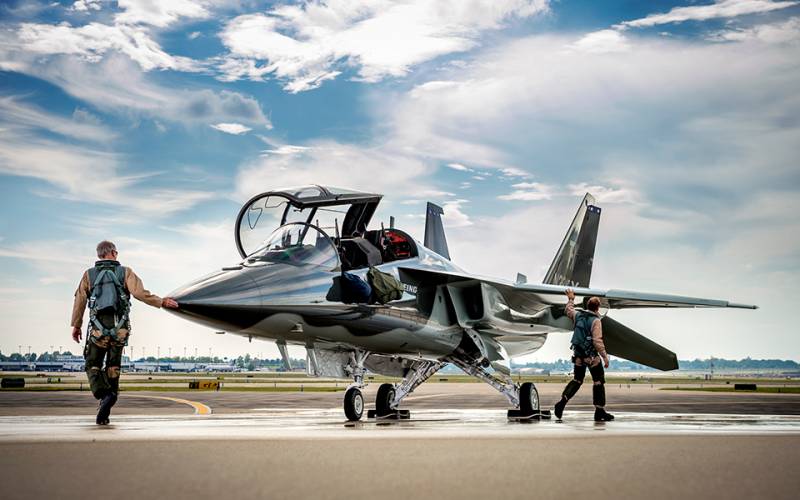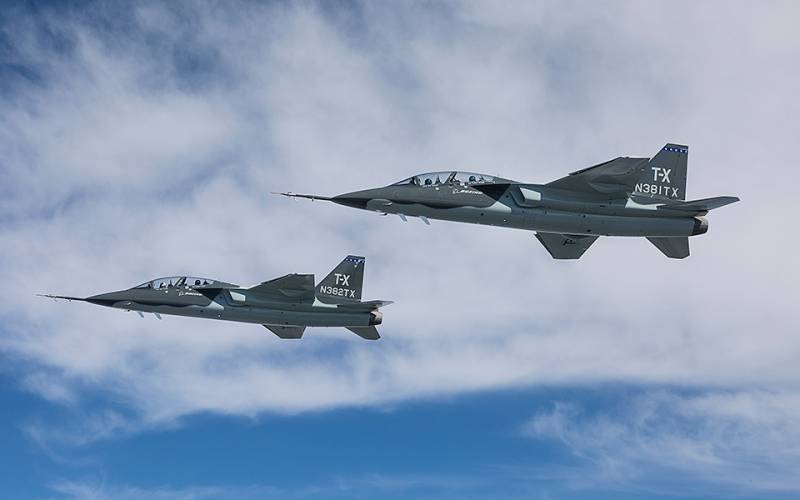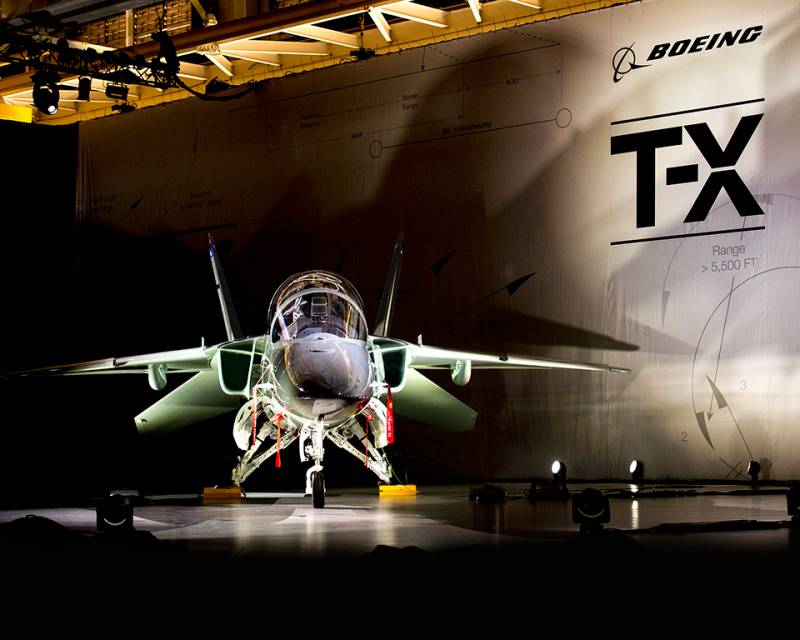TX project news. The name is new, the plans are old

New name
The Secretary of the Air Force Matthew Donovan announced the introduction of the new index and the proper name of the 16 aircraft in September in his speech at the Aerospace and Cyber Conference of the Air Force Association. In addition, the head of the department revealed the reasons for choosing a name for the aircraft.
The name Red Hawk ("Red Hawk") pays tribute to the famous American pilots and equipment of the Second World War. It recalls the "pilots from Taskigi" - the first African American pilots in the US Army Air Force. Pilots of the 332 fighter group used the characteristic coloring of the technique with red tails, for which they received the corresponding nickname.
The 99 fighter squadron of the 332 group, equipped with black personnel, operated the Curtiss P-40 Warhawk fighters. This fact is also noted in the name of the promising T-7A aircraft.
During the conference, the Minister of the Air Force demonstrated a promising image of the TCB in a characteristic form. This T-7A received a gray-white color and a red tail - almost like that of the "pilots from Taskigi." Perhaps such a livery will be used on serial Red Hawk.
Already under the new name, TCB will pass the necessary tests and then enter the series. The completion of development work will take the next few years, after which the Red Hawks will replenish the Air Force fleet.
Plans for the future
The US Air Force TX program kicked off earlier this decade. Its goal was to create a new TCB capable of replacing existing Northrop T-38 Talon machines. In the competition for the development of such a sample, several American and foreign companies participated. Since 2013, Boeing (USA) and Saab (Sweden) have been doing their project.
In September 2016, the first Boeing Saab TX (BTX-1) was first shown to the public. At the end of that year, he made his first flight. Soon the second prototype of the BTX-2 appeared. After carrying out part of the necessary tests, the Air Force made a decision. At the end of September 2018, it was announced that the joint project Boeing and Saab was winning the TX contest. After that, a contract was signed to carry out work as part of the Engineering and Manufacturing Development phase.
The current agreement worth more than 810 million dollars provides for the completion of the project and the construction of five prototypes. Seven ground-based simulators should also be made. Delivery time is up to 2023. After the completion of EMD, full-scale serial production is expected to start.
Last year's contract provides for the construction of a new type of 351 TCB and 46 simulators. Moreover, the possibility of increasing the order was previously mentioned. In this case, 475 vehicles of the T-7A and 120 ground training complexes could contract. However, the proposal to expand the order was not approved - the Air Force should receive only 351 aircraft. The total value of all ordered products will amount to 9,2 billion dollars. Equipment will be supplied from the beginning of the twenties to the 2034 financial year.
Production plans include the delivery of two batches of pre-production equipment, after which the construction of eight more numerous series will begin. The glider and part of the aircraft units will be manufactured at the new Saab plant in the United States, the construction of which will begin in the near future. The production of other components and the final assembly will be entrusted to the Boeing factory.
The first T-7A squadron will have to reach initial operational readiness at 2024. The introduction of all the ordered equipment will continue until the mid-thirties. As a result of these works, the new Red Hawk TCB will completely replace the existing Talon.
Project Objectives
The TX / T-7A training aircraft is being created as a key element of the advanced Advanced Pilot Training System. In addition to the TCB, this complex includes various ground-based equipment, primarily a simulator and related systems.
Such a complex should provide training for pilots who will fly on modern fighters of the 4 + and 5 generations. The existing T-38 aircraft, despite repeated upgrades, no longer meet these requirements, which led to the launch of the new TX program.
It was previously argued that to meet the current requirements for TCB, the promising TX / T-7A was developed from scratch, without using a ready-made base. At the same time, the accumulated experience of creating various aviation technicians. The use of modern approaches to design and turnkey solutions allows you to speed up the process of testing and refinement. However, the gain in this regard is not too great. The first flight of the experimental TX took place in 2016, and the service of serial T-7A will begin no earlier than 2023-24.
The Boeing / Saab T-7A Red Hawk is built according to the normal aerodynamic design with a high wing, two-tail plumage and one turbojet engine. The glider meets the requirements for strength and resistance to overload. Due to the General Electric F404 engine, the aircraft will be able to overcome the sound barrier and show the flight characteristics necessary for training pilots.
The on-board equipment complex is built on a modular basis with the ability to replace individual components. The equipment provides simulation of flight and combat use of various types of aircraft, including the newest. In the future, it is possible to upgrade the devices and software of the Red Hawk to train pilots of new types of cars.
In the early years, T-7A services will be used in training tactical aviation pilots to work on modern types of aircraft. In the future, with the advent of new fighters and bombers, it is possible to finalize Red Hawk accordingly. The operation of the new TCB will continue for several decades. Perhaps in this regard, the T-7A should repeat the successes of the old and well-deserved T-38.
It is curious that the bulk of the information about the tactical and technical characteristics and target capabilities of the T-7A TCB has not yet been publicly published. Nevertheless, the developers and the customer talk about the full implementation of all the tasks and almost a major breakthrough in the field of training aviation.
Modern replacement
The U.S. Air Force currently has 10 training squadrons using the Northrop T-38 Talon TSD. These units are armed with about 500 aircraft of modifications “A” and “C”. The existing equipment provides training for the flight crew, but already imposes serious restrictions.
First of all, the effectiveness of the preparation is affected by the age of the technique. The last T-38 were built in the early seventies, and their age is approaching the 50 years. Timely repair and modernization allows you to continue operation, but does not solve all the problems. The equipment is outdated and does not meet all modern requirements related to the preparation of pilots for fighters of the last generation.
The first squadron on the new T-7A will begin service in 2024. By this time, even the newest T-38 will have time to celebrate a half-century anniversary, which will emphasize the need to replace them. Fortunately for the US Air Force, at that time the replacement would already be real and feasible with the help of an existing project. The situation with the training of flight personnel is normalizing.
Serial production of the new Boeing / Saab T-7A Red Hawk will begin only in a few years, and the American industry should not lose time, since the existing TCB needs to be replaced as soon as possible. However, there is no need to rush either. The new “Red Hawks” will have to serve for several decades, and this makes certain demands on today's work.
- Ryabov Kirill
- Boeing Company / boeing.com, United States Air Force



Information